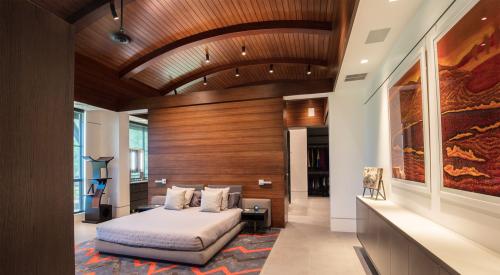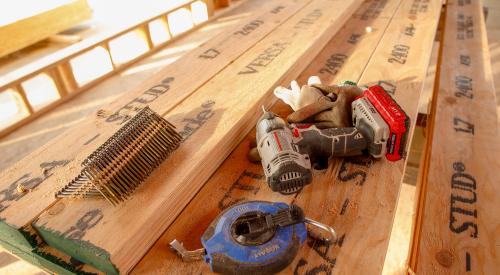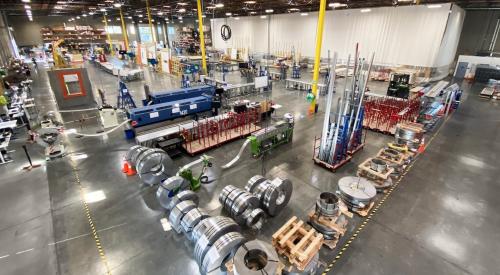Would you build a home with bamboo? BamCore says its wall system is stronger and more sustainable than traditional lumber.
BamCore received a 2021 Ivory Innovations Award for Design and Construction based on its solutions for the industry’s ongoing skilled labor shortage and building materials shortage.
Chief Marketing Officer and Director of Business Development Zack Zimmerman sat down with PRODUCTS Associate Editor Caroline Broderick to share details on the system and its features.
Zimmerman argues bamboo timber is stronger than lumber, better on the environment, and faster to obtain. Watch the interview above or read the transcript below to learn more.
Video Transcript:
Zimmerman: As a company, BamCore was actually founded in 2008, but it really was not until 2015 when the company started to commercialize itself. There was a lot of stepping stones that happened between 2008 and 2018, but effectively here we like to say that the company really started to hit the market in about 2015. We got our our first set of code compliance in 2016. We're code compliant under the IRC and the IBC, can build up to 85 feet and that is what launched it all.
Broderick: Tell me a little bit more: Why bamboo?
ZZ: Bamboo it's an amazing amazing material, and when you look at the built environment, the built environment's the largest single contributor to global greenhouse gas emissions. And when you have the ability to input a material that allows you to continue to sequester or carbon sink into a durable goods, such as bamboo turning into a panel of structuralized form, well you can make a huge carbon impact.
But structurally speaking our design is very unique because we have essentially a hollow wall a wall that has been able to eliminate 80% of traditional in-plane materials. So studs, headers, posts, tremors, kickers, you name it.
We are a bamboo-wood hybrid solution, but to be able to do that you need some sort of strong member and bamboo timber bamboo is unbelievably strong. Not only in compressive strengths but in tensile strengths and so that's why bamboo, because it wins on two fronts. One: it allows you to have a highly insulative envelope, but it also allows us to start to engineer carbon sequestering materials more efficiently and faster into the built environment, which arguably we need.
CB: Tell me more about BamCore and the product that you're offering to builders.
ZZ: Today in the market we have what we call the BamCore prime wall system, and what that is is it's a dual-panel assembly. So you still use traditional wood members for your bottom plates
your top plates and then any of your window and door blocks, but what it is is it's a custom bespoke form of material that's delivered to every single job.
Let me step back and explain. We are a custom prefabricated penalized structural wall—a little bit of a mouthful—but what we do is we take a set of plans, any plans, and we effectively BamCore-ize it. So we utilize revit and some other programs we will go through and we will fully 3D-dimensionalize out the building so we can understand where every single 4-foot wide by either 8, 9, or 10-foot tall individual panels go in place and then we custom fabricate all of those panels to meet the jobs requirements. Every door opening, every window opening, every plug, switch plate location is all fabricated here at the factory.
What that allows the builder is an ease of installation. A lot of the errors are taken out of the job site in building effectively. When we panelize our building, we start from a whole set of guidelines where individual seams need to line up. We don't put a seam at the edge of a
window for example, so you don't always have a pure mix of 4-foot panels in a straight run, you have a mix of different sizes and it's a kit of parts, but it's a very accurate kit of parts that allows you to substantially speed up the time of installation in the field.
CB: So what's that process like when you work with builders? Let's say they have this plan. So what's that process from meeting with you until setting those up on the jobsite?
ZZ: We are unique in that we are a material supplier but we are a heavily involved material supplier, so it is always really great to get in on the beginning of the design. There are a couple little nuances architecturally speaking, and let me hit on that real quick, because this is really the only architectural nuance that we have.
Our base assembly, which is based off of a two-by-six wood plate, so when you have your two-by-six wood plates you have 2-inch-and-a-quarter-thick panels that face nail to that plate so your outer dimension of your wall starts at 8 inches. That is different than typical construction.
Typical construction, you're building on top of those plates and then you sandwich face nails to all that material and so your outer assembly is wider by a little bit. Ao what's nice is if we come into the design process early, that's accounted for. If we come into a design process later and the builder is having to make the decision for the owner, developer, whatever their constraints are having to make the decision of, “Do I shrink some interior square footage or do I have the possibility of growing out??
I mean we're not talking mass design changes here. We're talking maybe three quarters to an inch of design change. And then additionally we are an engineered good that goes into an engineered package, so the entire development is engineered with our design conduits. so we are the structural members that are replacing all of those traditional vertical members in building, whether that's a single-family home, whether that's a five-over-two podium structure, regardless, we are the structural exterior load-bearing materials.
So for us to be able to go through and have peer-to-peer conversations with our internal
engineer and then the client's engineer, the process really is a smooth process. But we stay involved because once the architect has designed the structure and has been engineered and we're ready to start to fabricate, we go through a design iteration in-house, making sure that we then are taking the architectural designs and integrating that properly into our system.









